An eye to the future and a nose for business — that was my uncle Howard Watt. No surprise that he was one of the pioneers in commercial aviation in Canada, the holder of licence number 214, dated 2 March 1926.
No surprise either that in early 1931 he was sent up to Kapuskasing in Ontario’s North country to check out the freight and passenger market for Toronto-based National Air Transport (NAT). The trip was made at the request of the company’s president and managing director, First World War ace Earl M. Hand, DFC.
The big surprise was discovering this unknown chapter in Uncle Howard’s career. By a complete fluke, it came to light in an online copy of the Porcupine Advance, a community newspaper published in Timmins from 1912 until 1950. Back on 12 February 1931, the Advance reprinted an article on Watt’s visit that had appeared in the previous issue of the Kapuskasing newspaper, The Northern Tribune.
Large Cabin Plane Zooms Over
There was a buzz of excitement around “Kap” according to The Tribune, when an “unusually large cabined plane zoomed over in the early afternoon on Thursday this week.” Float planes were a common summer sight in this town 500 miles (800 km) north of Toronto, but it was rare to see an aircraft in winter. “The plane was the CF-ACX, a six-passenger cabined Buhl Airsedan,” continued The Tribune, “piloted by Howard Watt, the first flier to take a pay-load into the Red Lake District in the gold rush of 1926. He had with him as assistant pilot Kelly Edmison, and a passenger, Norman Steen.” [See Note at end re Edmison and Steen.]
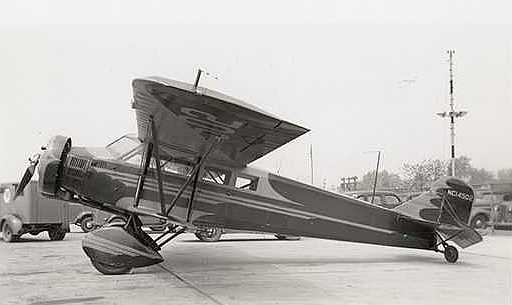
Buhl CA-6 Airsedan Special NC-14502, a fancier version of the CA-6 Airsedan than the Standard Model CF-ACX. Photo: William F. Yeager Aviation Collection, Wright State University, Dayton, Ohio.
The plane left Toronto at 11 a.m. Wednesday,* and was expected before sundown. But the weather closed in. Just out of North Bay they encountered very poor visibility due to a heavy snow storm. Pilot Watt decided to lay up overnight at Haileybury, and arrived in Kapuskasing at 3 p.m. on Thursday.
- Presumably 4 February 1931.
Where to land was the pressing question. Watt circled several times to reconnoitre. The river ice was plenty thick enough, but there were open cuts in the river where ice was being harvested for refrigeration, and teams of horses were going to and fro hauling sleds laden with ice blocks. The smooth fields of the Dominion Experimental Farm* caught his eye, and there, according to The Tribune, he made a perfect landing, with his “wide 18-inch skiis.”
- Kapuskasing Airport was subsequently built on the Experimental Farm property.
A Northern Welcome

The Kapuskasing Inn, built in 1928 and operated by the Spruce Falls Power and Paper Co., burned down in 2007. It was demolished in 2008. Photo via Postalhistorycorner.
Farm superintendent Ballantyne welcomed the air travellers and immediately sent out a team of horses with a roller to pack a runway for take-off. Meanwhile, his guests “partook of a hot dinner such as only a farm can put up for hungry men. The flying trio were more than astonished that everything appeared so “made-to-order” for their unexpected arrival, and expressed their delight,” reported The Tribune.
Touring the town after their meal, they visited the hockey arena, and then the Spruce Falls paper mill. At both the Community Club and the Kapuskasking Inn, the managers proudly showed the visitors over the premises from top to bottom.
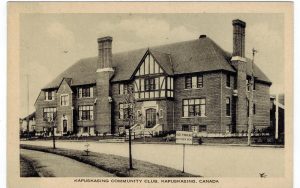
The Kapuskasing Community Club was built in 1928 by the Spruce Falls Power and Paper Co. for the benefit of its employees. Photo via Postalhistorycorner.
“They were loud in their praises of these institutions, and frankly said there was incredulity in Old Ontario that any town or city in the North possessed such superlative comforts and attractions, available alike for visitors and townspeople. When these attractions did really become known among the flying fraternity, they would certainly fly a crowline for Kapuskasing whenever they wanted to visit the North.”
To cap off their tour, Watt and his companions were received by Kapuskasing Mayor Noble and other executives of the growing town, whose population would soon number close to 4,000 people.
Opportunities in Northern Ontario
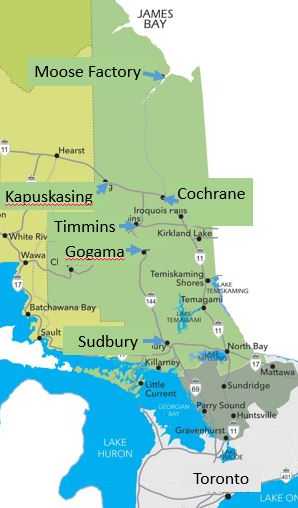
Map of Northeastern Ontario. Moose Factory and nearby Moosonee lie about 530 miles north of Toronto.
Watt explained to The Northern Tribune that in response to numerous recommendations made by the townspeople, his visit was intended to gauge opportunities for the flying business in this part of Northern Ontario.
He pointed out that the airplane had already proved indispensable in mineral prospecting in the less accessible regions of the country. All the activity then under way between Cochrane and Moose Factory could well lead to some pay-load freight requirements. Not to forget the possibility of a new strike in the Mattagami or Missinaibi areas, where airplane service could get things into “high gear” in short order. While in town, he said, he was ready to consider any business that might offer, and would stay as long as necessary to handle it.
The reporter asked whether air service from Toronto to Moose Factory might be established, with stops at Sudbury and Kapuskasing. Watt was skeptical that the public would pay the premium for plane travel where railways could be used, even if they could save a few days’ time. Consequently, he was surprised to receive eager assurances from the local people that he could get full passenger loads for trips to Timmins, Sudbury and Moose Factory. “These flying fans agreed with us,” the reporter wrote, “that when Mr. Watt’s presence here and availability became generally known in other towns, he would likely be kept busy for some time.”
Wrapping up the interview, Watt emphasized the importance of public support. To encourage people to become more “air-minded,” short demonstration flights would be offered for a modest charge of three dollars a head while CF-ACX was at Kaspuskasing. He stressed that public enthusiasm about aviation was important to every aviator, for it would guarantee the rapid development of aircraft. He concluded by saying that if “Canada would bask in the sun of modern security and prosperity, she must keep in the very forefront in aviation.”
Watt’s promotional trip crystallized NAT’s plans. In April 1931, Canadian Aviation reported that Frank H. Fisher, piloting CF-ACX with Kelly Edmison as co-pilot, carried out operations around Cochrane and Kapuskasing starting in February 1931. They made numerous trips into the surrounding mining districts and engaged in timber cruising for various lumber interests. Before break-up that spring, CF-ACX was chartered for a claims-staking journey to the Belcher Islands in Hudson Bay, some 350 miles north of Moosonee. Clearly the role of aviation as a key factor in the development of resource industries was becoming reality, and National Air Transport was playing its part.
CF-ACX: 1929-1933
The story of this Buhl CA-6 Standard Airsedan is brief. Manufactured in April 1929 by the Buhl Aircraft Company of Marysville, Michigan, construction number 44, she was imported from the United States that month. Her Canadian registration as CF-ACX was dated 14 May 1929.
Purchased directly from the manufacturer, she was initially based at Leaside Airport until NAT moved to Barker Field, on Dufferin Street, Toronto, in 1931. Only four American-built Buhl CA-6 Airsedans flew under Canadian markings, the other three being registered in Prince Albert, Saskatchewan. After the Buhl factory closed in 1932, the Ontario Provincial Air Service (OPAS) bought the engineering drawings and built four modified CA-6M Airsedans for their own use. (See Bob Grant’s two-part story on the OPAS Buhls, “Splashing and Spitting,” in Air Enthusiast, July/August and September/October 1995.)
The CA-6 Airsedan had a wingspan of 40 feet on the upper wings, but a width of only 26 feet,1 inch on the lower wings, giving it a distinctive appearance in the air. The aircraft length was close to 30 feet. Equipped with a 300 hp, 9-cylinder Wright J-6 (975) Whirlwind engine, CF-ACX had a cruising speed of 120 mph. Two fuel tanks with a total capacity of 98 U.S. gallons gave her a range of 720 miles. CF-ACX was approved for a gross weight of 4200 pounds as a landplane and 4500 pounds as a seaplane. Extra features included a hand-cranked inertia starter and wheel brakes.
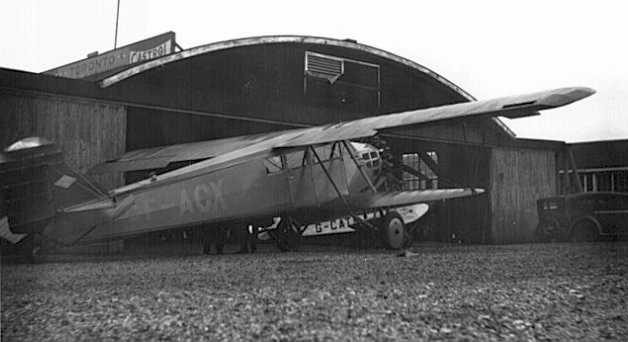
CF-ACX, a Buhl CA-6 Standard Airsedan. was registered to National Air Transport on 14 May 1929. Photo: Canada Aviation and Space Museum No. 2117.
CF-ACX operated on wheels and skis for two years. When inspected on 13 May 1931 for renewal of her Certificate of Airworthiness, she had logged 319 hours and 40 minutes of flying time since new.
CF-ACX Hits the Ditch
Plans for bush work meant CF-ACX needed floats. On 7 August 1931, she was flown from Toronto to Fairchild Aviation Ltd. at Montréal. An encounter with a ditch on landing left her badly damaged. The undercarriage was ripped off, the 9-foot Hamilton Standard steel propeller was badly bent, the engine mount was torn, ribs in the wings were broken and bent, and the whole aircraft had to be completely re-covered with new fabric.
The only saving grace was that Fairchild Aviation was ideally qualified to make all the repairs. At the same time, Fairchild filled the original order, installing its P-4 floats and the required undercarriage mount.
Fire Fighting at Gogama
Come May 1932, CF-ACX was operating as a floatplane, stationed at NAT’s base at Gogama. There her assignment, along with CF-AAP, the company’s Fairchild FC-2, was to support firefighters battling the Sheard Township forest fire — the most serious of more than 100 fires blazing in Northern Ontario that month. Before it was extinguished, the Sheard fire destroyed 1,000 acres of jackpine and spruce at the headwaters of Algoma’s Montreal River.
On 26 May, CF-ACX and two other aircraft worked all day airlifting 100 reserve fire fighters and their gear from Gogama to the fire site. With their tanks of gasoline and aircraft wings like tinder, the pilots challenged fate every time they landed on a fire-ringed lake to drop off the fresh crews. But their efforts helped win the day. By the end of the month, the fire was under control, aided by a heavy rainfall over most of Ontario.
No sooner was the Sheard township fire under control than Fairchild CF-AAP (construction number 61) was lost on 1 June to an engine fire at NAT’s Gogama base on Lake Minisinakwa.
The incident, related to the Sheard fire only by unlucky timing, was described in a feature article that appeared a year and a half later in the Winnipeg Tribune in October 1933. Pilot Mike Poupore was warming up the engine near the seaplane dock at 5 a.m., wrote reporter Bert Stoll, getting ready to fly out to bring some of the fire fighters back to Gogama when the engine backfired and the plane caught fire. “To save himself, Poupore dove into the icy water and had a long, cold swim back to the seaplane dock.”
In a June 9 letter to J.A. Wilson, the Controller of Civil Aviation, company president Earl Hand wrote: “We are now working on the wreck. I will report in the near future as to whether or not we will write this machine off.” The aircraft was never repaired, and the registration lapsed.
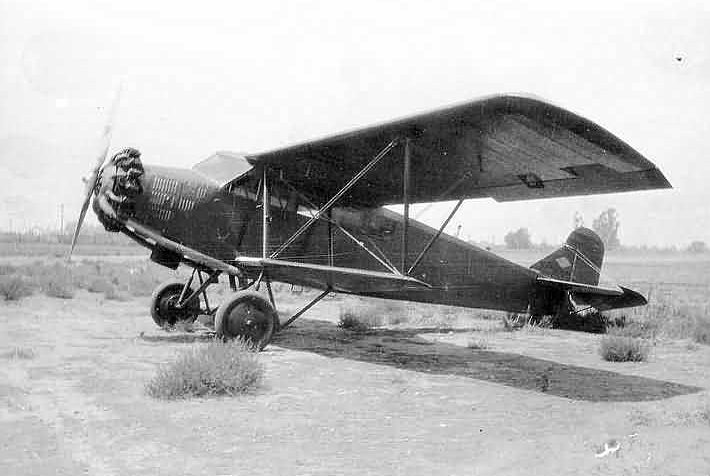
Buhl CA-6 Airsedan. Photographed at Daugherty Field, Long Beach, California, USA, by Norman Loop. Photo credit: Pat Loop Collection, 1000aircraftphotos.com. By permission of Ron Dupas.
CF-ACX – Another Fire Casualty
Summer 1933 saw CF-ACX in Muskoka, catering to sports fishing enthusiasts and giving short rides to young people at the various summer camps in Algonquin Park. On her return from such a flight, disaster struck the Buhl, when she mysteriously caught fire on landing.
“We are unable to give you a definite report as to the cause of the fire,” wrote Earl Hand in his letter of 2 October 1933 to the Civil Aviation Branch. On 11 September 1933, his letter continued, CF-ACX glided in and landed on the water near Huntsville, Ontario. While taxiing in to the beach, the pilot spotted fire near the front of the fuselage. He was sure the engine had not backfired, and equally sure there had been no cigarette smoking in the cabin since he was alone. The cause of the fire was a complete enigma.
The company decided against rebuilding after they hauled the fuselage back to their headquarters at Barker Field, Toronto, and carried out a detailed inspection. This incident marked the demise of CF-ACX, after a service life of only four and a half years.
NOTE
Kelly Edmison (1908-2000) went on to fly for General Airways in Rouyn before joining Trans-Canada Air Lines (TCA) in January 1938. On 1 April 1939, the first day of TCA’s Montréal-Vancouver passenger service, Edmison was captain on the Toronto-Winnipeg segment, routed via Kapuskasing due to bad weather at North Bay. During the Second World War, he served on secondment with the Canadian Government Transatlantic Air Service, flying Lancastrians. He spent the rest of his career with TCA, later renamed Air Canada, and retired in 1972 as the Regional Operations Manager of the Western Region.
Norman Steen was a cousin of Howard Watt.
ACKNOWLEDGEMENTS
Sincere thanks to readers who commented on a draft version of this post: Robert S. Grant, Chris Hargreaves, Ian Macdonald and Johan Visschedijk. Thanks also to George Fuller for continuing research suggestions and encouragement.
A tip of the hat to the late author of the blog at Postalhistorycorner, Andrew J. Liptak (1948-2014). There are nearly 750 postings on this blog which is now managed by the Postal History Society of Canada.
SOURCES
“Buhl Airsedan.” Specifications – CA-6 ATC# 128, https://en.wikipedia.org/wiki/Buhl_Airsedan Retrieved 1 April 2020.
“Downpour Brings Results Worth Millions.” Ottawa Citizen, 27 May 1932, p. 1.
Library and Archives Canada, Aircraft Registration file for CF-ACX – Buhl CA-6, Microfilm T-7420. Also for CF-AAP – Fairchild FC-2, Microfilm T-7417.
Liptak, Andrew J. “Kapuskasing Ontario: The Model Town of the North,” published 14 December 2010. http://postalhistorycorner.blogspot.com/2010/12/kapuskasing-ontario-model-town-of-north_14.html Retrieved 2 April 2020.
“Little Gain in Struggle against Fire.” Saskatoon Star-Phoenix, 15 June 1932, p. 1.
McGrath, T.M. History of Canadian Airports. Toronto: Lugus, 1992.
Porcupine Advance, Timmins, Ontario. Thursday, 12 February 1931. Retrieved 31 March 1931.
Stoll, Bert. “Daring Death in Canadian Forest Fires.” The Winnipeg Tribune, 7 October 1933, p. 31.

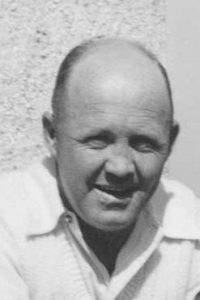

Great to see more of the almost unknown Buhls in Canada. Thanks, Diana!
Well done cousin.